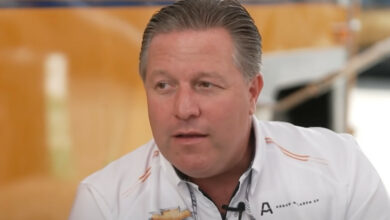Meet The Gorgeous New Aston Martin DBS Superleggera
It was difficult to believe Aston Martin when they said they would be releasing a new model every nine months. But low and behold, they’ve once again kept their promise by releasing the new DBS Superlaggera, and my God is it it a stunner. It replaces the outgoing Vanquish S as Aston Martin’s range topper and of course sees the return of the DBS name from 2012 and the Superleggera name from 1967. And damn am I glad to see it back.
Obviously, it works with similar design cues from the DB11 with only the glass house and doors making a reappearance, but while this is no stripped out race car, it incorporates an evolved carbon fibre and aluminium body. It is therefore 72kg lighter than the DB11 V12, putting it bang on the 1,800kg mark.
But who cares about weight when you have a twin-turbocharged V12 at the back and call of your right foot? This V12 boasts a comfortable 715bhp and 664lb ft of torque from the 5.2-litres which surges through a carbon fibre driveshaft straight to the rear wheels. Thank God for traction control, eh?
Thankfully the wheels are wrapped in sticky Pirelli P Zeros, which manage to tame the endless torque to a 0-62mph figure of 3.4 seconds. Maybe not quite as fast as you’d expect considering the power, but this car is a Super GT after all. However, nothing will stop it from reaching its top speed of 211mph. These figures stick the GT car right in between the likes of some serious supercars, although going by driving dynamics, it goes head to head with Ferrari’s GT, the naturally aspirated 812 Superfast.
While it still won’t quite keep up with the likes of the 720S or 488 Pista, it wields carbon ceramic brakes – 410mm at the front and 360mm at the rear – and an adaptive suspension with bespoke geometry, sitting 5mm lower and standing with more negative camber both front and rear, helping muscle the car through corners. And of course, like most new performance cars, it has torque vectoring and a slurry of technology to make the car perform flatter and feel more nimble.
“While we wanted to create a very, very fast car, it was crucial that it didn’t terrify less experienced drivers,” says Matt Becker, vehicle dynamics chief. “To this end, we’ve honed the dynamics so that it’s agile and connected, but also linear and progressive as you work towards its limits. Much like we’ve tuned the engine to deliver the meat of its performance at real-world revs, we’ve tuned the handling to engage and reward drivers of all ability levels.”
Aston keeps the drama going throughout the exterior with gashes and wings and diffusers with design characteristics from both the DB11 and Vulcan. And how can we not mention that basking shark-esque front grill? All these theatricals result in 180kg of downforce at 211mph – more than any Aston yet, but at what price does this come?
It’s not cheap at £225,000. That’s £50,000 more than the 621bhp DB11 V12 AMR, but £38,000 less than the horse badged 812 Superfast. So all in all, not a bad deal if you’re in the market for a range topping British tourer.

